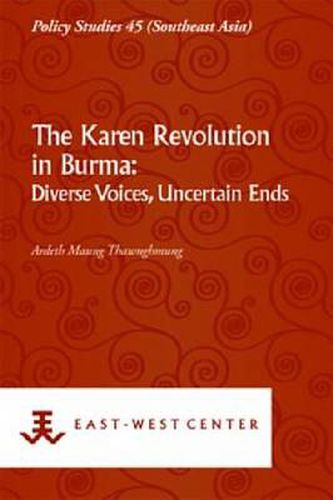Readings Newsletter
Become a Readings Member to make your shopping experience even easier.
Sign in or sign up for free!
You’re not far away from qualifying for FREE standard shipping within Australia
You’ve qualified for FREE standard shipping within Australia
The cart is loading…






This title is printed to order. This book may have been self-published. If so, we cannot guarantee the quality of the content. In the main most books will have gone through the editing process however some may not. We therefore suggest that you be aware of this before ordering this book. If in doubt check either the author or publisher’s details as we are unable to accept any returns unless they are faulty. Please contact us if you have any questions.
This study analyzes the various types and stages of conflict that have been experienced by diverse groups and generations of Karen over the six decades of armed conflict between the Karen National Union (KNU) and successive Burmese governments. Instead of focusing on those who are internally displaced, those in the refugee camps on the Thai-Burma border or living abroad, or those in the KNU, it places particular emphasis on the ‘other’ Karen - the majority segment of the Karen population living inside Burma - a population that has hitherto received little scholarly and journalistic attention. It also assesses the Karen people’s varied attitudes towards a number of political organizations that claim to represent their interests, towards successive Burmese military regimes, and towards the political issues that led to the original divide between the ‘accommodators’ and ‘rebels’. This study argues that the lifestyles and strategies that the Karens have pursued are diverse and not confined to armed resistance. Acknowledging these multiple voices will not only shed light upon the many positive features of ethnic interactions, including harmonious communal relationships and significant attempts to promote peace and stability by encouraging ‘normal’ activities and routines in both peaceful and war-torn areas; it will also help to identify policy recommendations for future ceasefire negotiations and a possible long-term political settlement within the context of a militarised Burma.
$9.00 standard shipping within Australia
FREE standard shipping within Australia for orders over $100.00
Express & International shipping calculated at checkout
This title is printed to order. This book may have been self-published. If so, we cannot guarantee the quality of the content. In the main most books will have gone through the editing process however some may not. We therefore suggest that you be aware of this before ordering this book. If in doubt check either the author or publisher’s details as we are unable to accept any returns unless they are faulty. Please contact us if you have any questions.
This study analyzes the various types and stages of conflict that have been experienced by diverse groups and generations of Karen over the six decades of armed conflict between the Karen National Union (KNU) and successive Burmese governments. Instead of focusing on those who are internally displaced, those in the refugee camps on the Thai-Burma border or living abroad, or those in the KNU, it places particular emphasis on the ‘other’ Karen - the majority segment of the Karen population living inside Burma - a population that has hitherto received little scholarly and journalistic attention. It also assesses the Karen people’s varied attitudes towards a number of political organizations that claim to represent their interests, towards successive Burmese military regimes, and towards the political issues that led to the original divide between the ‘accommodators’ and ‘rebels’. This study argues that the lifestyles and strategies that the Karens have pursued are diverse and not confined to armed resistance. Acknowledging these multiple voices will not only shed light upon the many positive features of ethnic interactions, including harmonious communal relationships and significant attempts to promote peace and stability by encouraging ‘normal’ activities and routines in both peaceful and war-torn areas; it will also help to identify policy recommendations for future ceasefire negotiations and a possible long-term political settlement within the context of a militarised Burma.